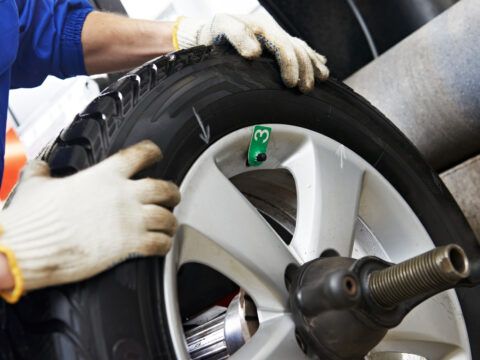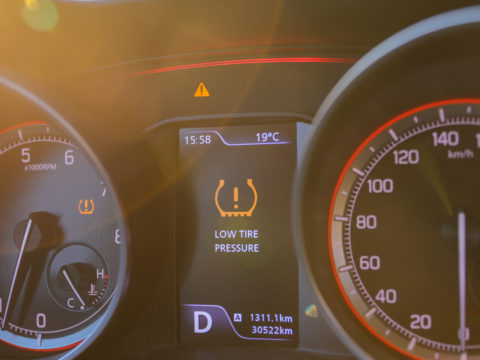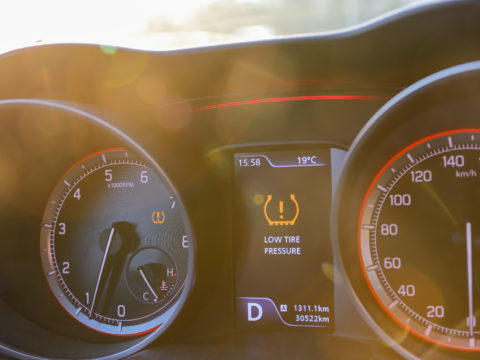A tire pressure sensor indicates low tire pressure and illuminates the dashboard symbol to alert the driver to a potential issue. Sometimes the tire pressure sensor fault will alert car owners to air pressure that is too low or too high, but other times, this indicates an issue with the tire pressure monitoring system.
Let’s look at common reasons the error message lights up and how to fix the tire pressure sensor fault.
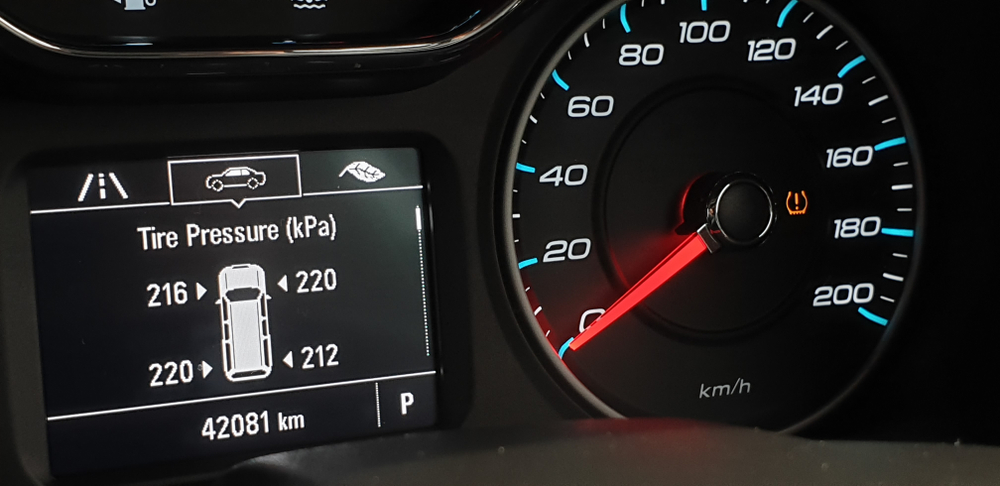
Contents
Meaning
A tire pressure sensor fault on a Ford F150 is an error message displayed on the vehicle’s dashboard, indicating that there is an issue with the Tire Pressure Monitoring System (TPMS) sensors.
The TPMS constantly monitors the air pressure in your tires and alerts you if it falls below or exceeds recommended levels. When a fault occurs, it means that the system cannot accurately measure tire pressures due to malfunctioning sensors.
What Causes the Error?
The tire pressure sensor fault on a Ford F150 can be caused but several issues.
Damaged TPMS Sensor
The most common cause of a tire pressure sensor fault is damage to the Tire Pressure Monitoring System (TPMS) sensor. These sensors are located inside each wheel and constantly monitor the air pressure within your tires. Over time, road debris, corrosion, and wear and tear can cause damage to the sensor.
Low Battery in TPMS Sensor
Each TPMS sensor has an internal battery that typically services for five to seven years. As batteries age, their performance declines, and a low battery in a vehicle’s sensor could trigger a tire pressure sensor fault warning.
Incorrect Tire Inflation
If one or more of your tires are underinflated or overinflated beyond the recommended range set by Ford, it may cause a tire pressure warning light to appear on your dashboard. Regularly checking and adjusting your tire pressures can prevent this issue.
Changes in Ambient Temperature
Tire pressures naturally fluctuate as temperatures change throughout the day – increasing in warm temperatures and decreasing in the cold. If the vehicle’s TPMS sensors detect a significant change in tire pressure due to temperature fluctuations, it may trigger a fault warning.
Damaged Wiring or Connections
Damaged wiring or poor electrical connections between TPMS sensors and the computer system can cause false readings. Inspecting and repairing any damaged wires or connectors can help resolve this issue.
How To Fix the Tire Pressure Sensor Fault
If your Ford F150 is experiencing a tire pressure sensor fault, the following steps can help resolve the issue.
Check and Adjust Tire Pressures
Check tire pressure and confirm all tires are filled to the recommended PSI levels, which can be discovered on a label inside the driver-side door or in your vehicle manual.
Inspect for Damaged Sensors
Damaged or faulty sensors may trigger a TPMS warning light. Visually inspect each wheel for any signs of damage or corrosion around the valve stem area where the TPMS sensor is located. If you find any issues, consider replacing them with new ones.
Reset TPMS System Using the Reset Button
If your Ford F150 has an available TPMS reset button, press it after ensuring proper inflation levels have been set on all tires. This should clear any faults from previous low-pressure readings and allow fresh data from properly inflated tires to be read by the system.
Seek Assistance
If your tire pressure sensor fault persists despite following the instructions in the vehicle’s owner’s manual, it is best to seek assistance from a qualified mechanic or Ford dealership.
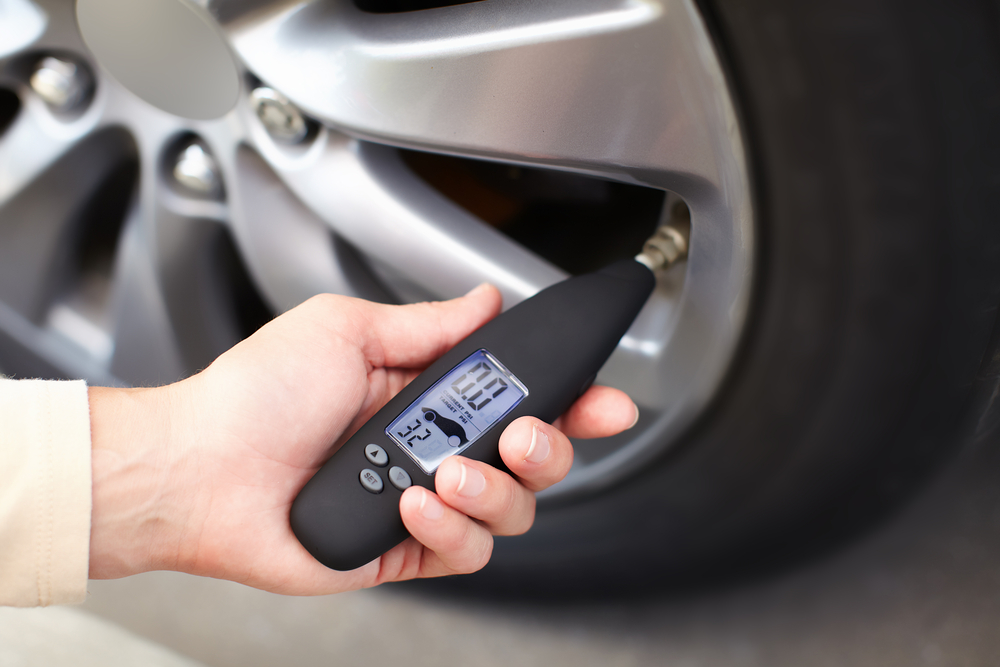
Where Is the F150 TPMS Reset Button?
The reset button for the Ford F150’s tire pressure sensor is typically located either underneath the steering wheel or in the glove box.
Check for a small, round button labeled “SET” or “RESET” located beneath or on either side of your vehicle’s steering column. This is typically where you’ll find it in older models such as those from 2007-2013.
Some newer models from 2015 to the present have reset buttons located inside the glove compartment.
Can You Fix the Fault Yourself?
With some fundamental knowledge and tools, you can troubleshoot and fix the tire pressure sensor fault yourself.
First, you’ll want to identify which tire pressure sensor failed. You can do this using a tire pressure gauge and comparing readings from all four tires with those displayed on your vehicle’s dashboard.
Once you’ve identified the problematic sensor, visually inspect it for signs of physical damage, such as cracks or corrosion, that could be causing issues with its functionality.
In some cases, a dead battery within the TPMS sensor may cause faults to occur; replacing these batteries can potentially resolve problems related to low voltage signals being sent from sensors back to your vehicle’s computer system.
If you’ve addressed physical damage and replaced dead batteries but still experience a tire pressure sensor fault, you may need to reset your F150’s TPMS system using the appropriate reset button. This can help clear any lingering error codes and restore proper function to your sensors.
Repair Cost
Repair expenses for this fault can be affected by multiple elements, including the cause of the problem and whether you decide to do it yourself or seek assistance from your mechanic.
A new TPMS sensor for an F150 typically costs between $50 and $100 per unit. Remember that each tire requires a sensor, and there are four in total.
If you decide to have a mechanic replace your sensors, labor charges will be added to your overall repair bill. On average, labor rates range from $75 to $125 per hour, depending on location and shop reputation.
Can You Drive With Tire Pressure Sensor Fault?
While it might be possible to drive short distances with the tire pressure sensor fault illuminated, there are potential risks. Addressing a tire pressure sensor fault quickly helps ensure optimal fuel efficiency for your F150.
- Incorrect tire pressure presents a safety hazard with reduced vehicle stability and poor handling.
- Overinflated or underinflated tires may wear unevenly and have a shorter lifespan than those maintained at proper pressures.
- Improperly inflated tires can negatively impact fuel economy.


